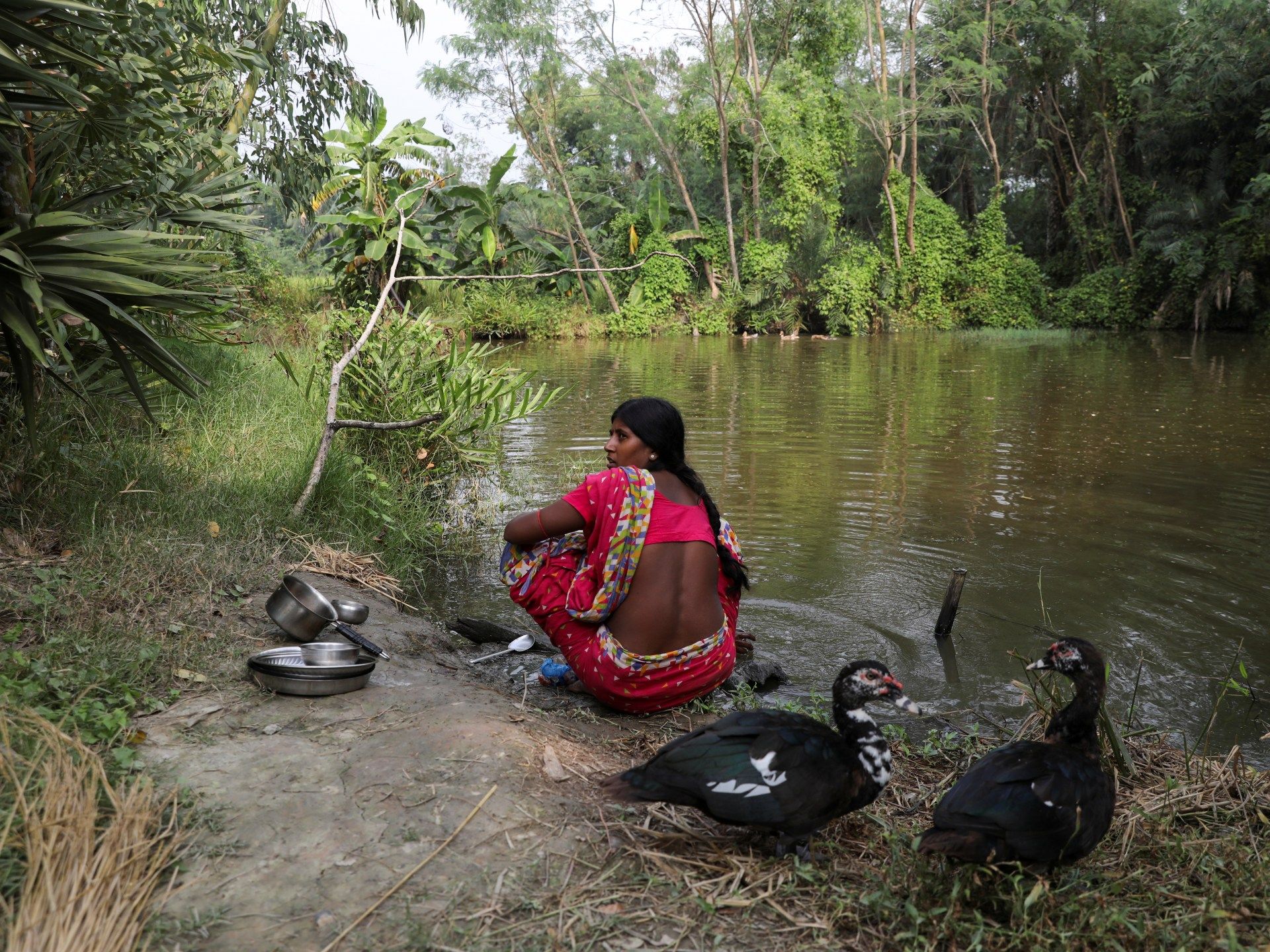India's flag – Panchanan Dolui, who lives on Mousuni Island in India's Sundarbans, has changed homes three times due to flooding and river erosion.
Each time, it moves further away from the edge of the receding island to avoid displacement. He has seen the river devour vast tracts of land. “Where are we going? There is nowhere to go,” she laments.
Located in the state of West Bengal in eastern India and neighboring Bangladesh, the Sundarbans forest system is a group of low-lying islands and represents the largest mangrove ecosystem in the world. It is home to several endangered species and acts as a natural barrier against cyclones, storm surges and other environmental hazards. Forests are also natural carbon capture and sequestration agents.
But things are changing quickly. Four cyclones that hit the eastern coast of India between 2019 and 2021 (Fani, Amphan, Bulbul and Yaas) point to the increasingly unpredictable weather in the Sundarbans caused by climate change and rising sea levels.
Now, the Sundarbans are increasingly “unsafe for human habitation”, says Kalyan Rudra, chairman of the West Bengal Pollution Control Board.
The onslaught of recent cyclones has aggravated the climate-induced displacements that the people of the Sundarbans have faced in previous decades. Lohachara was one of the first inhabited islands to disappear under the sea in 1996, forcing its residents to move to neighboring islands, often without documents or property titles.
With limited livelihood options and insufficient development in the region, migration has become a survival strategy for many residents. There have been several waves of migration within the Sundarbans, often on the same island, to avoid flooding caused by dam breaks, tides and storm surges.
Since Cyclone Aila in 2009, forced migration driven by economic vulnerability has caused men to take jobs as informal migrant workers across India.
Female-headed households in the Sundarbans are more common than in any other area of India due to hardship migration. But these households are often marked by debt burdens, large numbers of dependents, and limited livelihood options.
Meanwhile, rising salinity of the land due to severe cyclonic storms and the action of tidal waves, which transport seawater from the Bay of Bengal to the Sundarbans delta, impedes soil productivity.
Increased salinity forces changes in agriculture
Growing salinity-resistant rice paddies is an important way to adapt to climate change in the area and has become increasingly popular over the last decade.
However, rising salinity has also led to brackish water shrimp farming on a commercial scale, causing land degradation. The health of women who do the low-paid work of collecting shrimp seeds, which involves spending up to six hours in salt water, is negatively affected.
Rising salinity is a major cause of reproductive health problems among rural women in the Sundarbans, including pelvic inflammation and urinary tract infections. Rising salinity has also led to a severely degraded mangrove ecosystem, affecting biodiversity and leading to the loss of forest reserves that support local communities.
The wrath of the tigers
The pressure on forest resources also amplifies the conflict between men and animals in the area. The Sundarbans are home to tiger widows, women whose husbands went to the Sundarbans reserve to fish or collect honey and were killed by tigers.
There is no official recognition of such deaths because entry into the forest became illegal for its inhabitants once the area was declared a tiger reserve in 1973 and came under the Wildlife Protection Act of 1972.
Pradip Chatterjee, former president of the Dakshinbanga Matsyajibi Forum or South Bengal Fishermen's Union, calls these tiger deaths “be-aini mrityu,” or illegal deaths, marked by the elimination of the person from existence.
He points out that the local police station refuses to record tiger deaths due to their “illegal” nature, which makes the process of requesting compensation difficult: a bureaucratic maze that requires the relatives of the deceased to submit a police report and a death certificate. . Recently, the Calcutta High Court recognized the death of tigers in a landmark decision, ordering the West Bengal Forest Department to pay full compensation to two widowed tigers.
How the marginalized are left aside
Continuing climate disasters not only slow recovery but also exacerbate pre-existing caste and gender vulnerabilities. For example, government aid after disasters is often selective and contingent on existing land holdings, as was the case after Cyclone Amphan.
“Our two-bedroom house collapsed and trees fell on them. We could no longer enter our house,” said Neela Ghosh, a former resident of Sundarbans. “But the rescuers went to the houses that were not affected and where the owners do not live. “We are sitting outside our broken home and receiving very little funding.”
As erosion continues in the Sundarbans, officials are struggling to agree on suitable areas for the relocation of the most vulnerable residents. West Bengal recorded the longest stretch of coastal erosion in India at 63 percent, with 99 square kilometers (38 sq mi) of land lost due to coastal erosion from 1990 to 2016. This has a direct effect on marginal residents and landless of the Sundarbans, who reside closer to the river banks.
In a telephone interview, a Forest Department official said that prime land was already occupied in the Sundarbans and that people located on the edge (generally the most marginalized and vulnerable) would only be relocated to another edge. The rest of the public lands are not suitable for housing or agriculture, meaning that the only area that could become habitable or agricultural land would be the forest, the official added. Therefore, in responding to people forced from their homes due to erosion, government policy will have to tread carefully so as not to claim more forest land for relocation.
Decisions about where to relocate residents are made difficult by the fact that erosion has made some islands, including Sagar Island, to which planned relocation has been taking place, unsafe for human habitation, according to Rudra.
However, there are some areas in the Sundarbans where sediment accumulation is occurring, which presents possibilities. “We can identify areas that are less vulnerable and relocate some people who are really vulnerable there,” Rudra says.
But he underlines the impossibility of rehabilitating the entire Sundarbans population of more than 4.5 million people, adding that since erosion will continue, relocation is not a sustainable solution. “We have to live with this kind of disaster,” he says.
The future is at stake
In December, Kolkata, the state capital, became one of the first claimants for climate change-induced loss and damage from the Loss and Damage Fund, which was agreed during the United Nations COP28 summit. The fund will include coverage for climate-displaced populations in the Sundarbans.
In response to increasing threats due to climate change, the National Disaster Management Authority developed a draft policy in early 2023 which it refers to as the foundation of India's adaptation to climate change. Includes coastal and river erosion. The policy covers mitigation and resettlement of those displaced by such forms of erosion with the aim of reducing land loss, improving economic resilience and minimizing vulnerability.
However, uncertainty surrounds the future of climate resilience in this area because the allocation and disbursement of money is subject to the influence of politics. The central and West Bengal governments have a contentious relationship, which intensified during the review of damage caused by Cyclone Yaas in May 2021.
Piya Srinivasan is the India Commissioning Editor at 360info, organized by the Manav Rachna International Research and Studies Institute in Faridabad, India.
Originally published under Creative Commons by 360info












